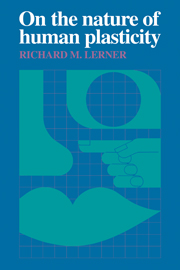Book contents
- Frontmatter
- Contents
- Foreword by Paul Baltes
- Preface
- 1 Perspectives on plasticity
- 2 The life-span view of human development: philosophical, historical, and substantive bases
- 3 Gene marking, recombinant DNA technology, and gene transfer: toward true gene therapy
- 4 Neuroanatomical bases of human plasticity
- 5 Human neurochemistry and the role of neurotransmitters
- 6 Evolutionary biology and hominid evolution
- 7 Comparative-developmental psychological bases of plasticity
- 8 Individual and group interdependencies
- 9 Toward future multidisciplinary efforts
- 10 Conclusions: On the limits of plasticity and the plasticity of limits
- References
- Author index
- Subject index
9 - Toward future multidisciplinary efforts
Published online by Cambridge University Press: 22 March 2010
- Frontmatter
- Contents
- Foreword by Paul Baltes
- Preface
- 1 Perspectives on plasticity
- 2 The life-span view of human development: philosophical, historical, and substantive bases
- 3 Gene marking, recombinant DNA technology, and gene transfer: toward true gene therapy
- 4 Neuroanatomical bases of human plasticity
- 5 Human neurochemistry and the role of neurotransmitters
- 6 Evolutionary biology and hominid evolution
- 7 Comparative-developmental psychological bases of plasticity
- 8 Individual and group interdependencies
- 9 Toward future multidisciplinary efforts
- 10 Conclusions: On the limits of plasticity and the plasticity of limits
- References
- Author index
- Subject index
Summary
The life-span view of human development emphasizes the potential for change across life. As such, plasticity is a key idea in this perspective. Plasticity is seen to arise because the levels of analysis involved in human life are not only themselves comprised of plastic processes but also because each level is reciprocally interactive with (embedded in) all others. Change at one level promotes changes at the others.
In this book I have reviewed theory and data from levels of analysis ranging from the genetic to the intergenerational, social network, and cultural. Although this review is not exhaustive, I believe that the evidence I discussed allows several conclusions to be made. First, at all levels of analysis, the variables considered are part of other processes, and means to manipulate the nature of these variables, or at least change their impact or outcome, are often available. Physical therapy with cerebral palsy children may not result in motor improvement above a “just noticeable difference.” However, the parents of children receiving such therapy may be made more optimistic, may feel less guilty or anxious, and may therefore enter into more positive interactions with their child; the child's feelings about him- or herself may in turn be positively altered, and this change will encourage the continuation of the parents' positive interactions with the child. Although the physical features of the child's functioning may still remain largely unaltered, because the child is embedded in a positive reciprocal relation with his or her context, the intervention may have a quite useful, albeit indirect (and perhaps unintended) effect.
- Type
- Chapter
- Information
- On the Nature of Human Plasticity , pp. 146 - 162Publisher: Cambridge University PressPrint publication year: 1984



